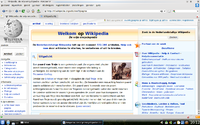KHTML
 Konqueror using KHTML to render the Wikipedia front page. |
|
| Developer(s) | KDE Team, Apple Inc., Nokia, Google, others. |
|---|---|
| Written in | C++ |
| Operating system | Cross-platform |
| Type | Layout engine |
| License | GNU Lesser General Public License |
KHTML is the HTML layout engine developed by the KDE project. It is the engine used by the Konqueror web browser. A forked version of KHTML called WebKit is used by several web browsers, among them Safari and Google Chrome. Distributed under the terms of the GNU Lesser General Public License, KHTML is free software.
Built on the KPart framework and written in C++, KHTML has relatively good support for Web standards. To render as many pages as possible, some extra abilities and quirks from Internet Explorer are also supported, even though those are non-standard.
Contents |
History
Origins
KHTML was preceded by an earlier engine called khtmlw or the KDE HTML Widget, developed by Torben Weis and Martin Jones,[1] which implemented support for HTML 3.2, HTTP 1.0, and HTML frames, but not the W3C DOM, CSS, or scripting.
KHTML came into existence in November 4, 1998,[2] as a copy of the khtmlw library, with some slight refactoring and the addition of Unicode support and changes to support the move to Qt 2. Waldo Bastian[3] was among those who did the work of creating that early version of KHTML.[4]
Re-write and improvement
The real work on KHTML actually started between May and October 1999, with the realization that the choice facing the project was "either do a significant effort to move KHTML forward or to use Mozilla"[5] and with adding support for scripting as the highest priority. So in May 1999, Lars Knoll[6] began doing research with an eye toward implementing the W3C DOM specification, finally announcing[7] on August 16, 1999 that he had checked in[8] what amounted to a complete rewrite of the KHTML library — changing KHTML to use the standard W3C DOM as its internal document representation. That in turn allowed the beginnings of Javascript support to be added in October 1999,[9] with the integration of Harri Porten's KJS following shortly afterward.
In the closing months of 1999 and first few months of 2000, Knoll did further work[10] with Antti Koivisto[11] and Dirk Mueller[12] to add CSS support and to refine and stabilize the KHTML architecture,[13] with most of that work being completed by March 2000. Among other things, those changes enabled KHTML to become the second browser after Internet Explorer to correctly support Hebrew and Arabic and languages written right-to-left[14] — before Mozilla had such support.
KDE 2.0 was the first KDE release (on October 23, 2000) to include KHTML[15] (as the rendering engine of the new Konqueror file and web browser, which replaced the monolithic KDE File Manager).
Other modules
KSVG was first developed in 2001 by Nikolas Zimmermann and Rob Buis; however, by 2003, it was decided to fork the then-current KSVG implementation into two new projects: KDOM/KSVG2 (to improve the state of DOM rendering in KHTML underneath a more formidable SVG 1.0 render state) and Kcanvas (to abstract any rendering done within khtml/ksvg2 in a single shared library, with multiple backends for ie. Cairo/Qt etc.)[16].
Standards compliance
The following standards are supported by the KHTML engine:
- HTML 4.01
- Partial HTML 5 support (standard still in progress)
- CSS 1
- CSS 2.1 (screen and paged media)
- CSS 3 Selectors (fully as of KDE 3.5.6[17])
- CSS 3 Other (multiple backgrounds, box-sizing and text-shadow)
- PNG, MNG, JPEG, GIF graphic formats
- DOM 1, 2 and partially 3
- ECMA-262/JavaScript 1.5
- Partial Scalable Vector Graphics support
KHTML and Apple
KHTML and KJS were adopted by Apple in 2002 for use in the Safari web browser. Apple publishes the source code for their fork of the KHTML engine, called WebKit.
See also
- List of KHTML and WebKit-based browsers
- List of layout engines
- Comparison of layout engines
References
- ↑ around 1:18 in December 8, 2006 From KDE to WebKit presentation at Yahoo! office by Lars Knoll and George Staikos http://yuiblog.com/blog/2006/12/11/knoll-staikos-video/
- ↑ around 4:52 in http://yuiblog.com/blog/2006/12/11/knoll-staikos-video/
- ↑ Waldo Bastian http://www.behindkde.org/people/waldo/
- ↑ around 5:02 in http://yuiblog.com/blog/2006/12/11/knoll-staikos-video/
- ↑ around 5:30 in http://yuiblog.com/blog/2006/12/11/knoll-staikos-video/
- ↑ Lars Knoll http://www.behindkde.org/people/lars/
- ↑ 1999-08-16 "changes in KHTML" message from Lars Knoll http://lists.kde.org/?l=kfm-devel&m=93489518402924
- ↑ 1999-08-16 "khtml_to_dom: kdelibs/khtml" commit message http://lists.kde.org/?l=kde-commits&m=93476738632582
- ↑ around 8:18 in http://yuiblog.com/blog/2006/12/11/knoll-staikos-video/
- ↑ around 9:10 in http://yuiblog.com/blog/2006/12/11/knoll-staikos-video/
- ↑ Antti Koivisto http://trac.webkit.org/projects/webkit/wiki/WebKit%20Team#AnttiKoivistoanttikreview>
- ↑ Dirk Mueller http://www.behindkde.org/people/dirk/
- ↑ around 9:32 in http://yuiblog.com/blog/2006/12/11/knoll-staikos-video/
- ↑ around 10:30 in http://yuiblog.com/blog/2006/12/11/knoll-staikos-video/
- ↑ around 11:10 in http://yuiblog.com/blog/2006/12/11/knoll-staikos-video/
- ↑ Re: Status of KSVG project by nikolas Zimmermann, January 25, 2005.
- ↑ K Desktop Environment - KDE 3.5.6 Changelog
External links
- Web Browser – list of KHTML features on Konqueror site
- KHTML – KDE's HTML library – definition from developer.kde.org
- KHTML from KDE API Reference
- The WebKit Open Source Project
- From KDE to WebKit: The Open Source Engine That's Here to Stay – video of December 8, 2006 presentation at Yahoo! office by Lars Knoll and George Staikos
|
||||||||||||||||||||||||||||||||||||||||||||||||||||
|
|||||||||||
